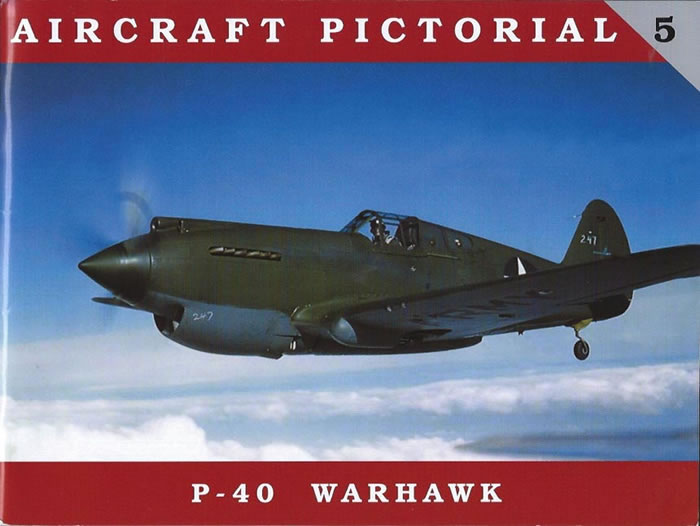Aircraft Pictorial #5
P-40 Warhawk
by Dana Bell

Classic Warships Publishing
| S u m m a r y |
Publisher, Title and ISBN: |
Aircraft Pictorial #5
P-40 Warhawk
by Dana Bell
Classic Warships Publishing
ISBN: 13-978-0-9857149-4-9 |
Media: |
Soft cover, Landscape A-4 Format, 72 pages plus covers. |
Price |
USD $16.16 from Squadron Mail Order |
Review Type |
First Read |
Advantages |
The first full explanation of the development of the “Long Nose” P-40. An excellent and invaluable resource. |
Disadvantages |
|
Conclusion |
An absolute necessity for anyone interested in the “Long Nose” P-40s, and a “should read” for all modelers and aircraft enthusiasts. |
Reviewed by Steven Eisenman

P-40 Warhawk by Dana Bell is available online from Squadron.com
In the name of transparency and disclosure, my name does appear in the “Acknowledgements”. In no way does this affect my objectivity. Now, the monograph.
First, Dana does not deal with the export version of the “Long Nose” P-40. This monograph focuses on the versions produced for the USAAC / USAAF. It seems that the export models were different beasties.
For modelers of US aircraft, a model of the Curtiss “Long Nose” P-40, especially in 1/48 scale, has been a bit of a holy grail. The cry for an accurate “Long Nose” P-40 has gone on for some time, and loudly at that. The issue that Dana’s monograph raises is which “Long Nose” P-40 do modelers want. As modelers, we usually think in terms of the B and C models. But, there was the initial production of the “Long Nose” P-40, without a suffix, and the modification that resulted in the P-40G. There were even a couple of P-40As.
The differences among the “Long Nose” P-40s are subtle, but they are there, and just as significant as the differences among the P-47Ds and Spitfire Mk. IXs. It also seems to have determined the camouflage and markings in which we see them.
In his brief, but comprehensive, introduction, Dana takes us through the development of the “Long Nose” P-40 and the significant problem of ground looping that required changes in the aircraft. Study closely the pictures on pages 13 and 17. What appears to be a little bit of Tamiya white putty shows the change quite nicely.
Dana has good reason for the little bit of self-congratulation that appears in the caption on page 17, for I believe it is truly a first. It will have us looking at the early “Long Nose” P-40s with a new understanding.
Dana carefully and fully deals with the change in armament in the “Long Nose” P-40, explaining the reasons and misconceptions in both word and picture.
As usual, Dana’s selection of photographs provide not only for an excellent “walk around” but also glimpses into the internal workings of the aircraft. The captions are extensive and informative. I have always wondered about those unusually long blast tubes for the nose guns, the reason for them and the reason they disappeared. In what I consider to be another first, Dana addresses this also.
But even with all of the great information contained in this monograph, it still may not be possible to have an “accurate” “Long Nose” P-40, whether it be a P-40, P-40G or P-40B. For according to Dana, much primary information, including the basic drawings, seems to have disappeared. Perhaps long thrown away. And perhaps that is the reason why the monograph does not have line drawing or elevations of the aircraft. Better not to have them, than put in “questionable” artwork.
But, as with all things, there is the occasional error or “ooops”. This occurs on page 36. Do not think color interpretation has reached new levels of subtlety, or that you cannot tell the difference between greenish green and brownish green, especially in a color photograph. Due to a printing error, they’re both green and the caption should be ignored. Although, the fabric surface of the elevator does look a “bit browner”.
A final note, Dana does explain the use of the descriptive term “Long Nose” and the suffix –CU, so we can have a common frame of reference.
It has come to my attention that some out there have confused shape and size with content. Since Dana’s monographs are the same shape and size as the Squadron “In Action” series, perhaps some have come to believe that what is between the covers is also the same or, at least, similar.
This cannot be further from the truth, and the differences are significant. Dana’s Aircraft Pictorial series is probably one of the most thoroughly researched works on the aircraft that is the subject of each of the monographs.
While brief in size, the information is extensive and focuses on details that larger volumes skim over or miss altogether.
Thanks to Dana Bell and Classic Warships Publishing for the review copy.

Review Copyright © 2013 by Steven Eisenman
This Page Created on 16 July, 2013
Last updated
16 July, 2013
Back to HyperScale Main Page
Back to Reviews Page
|
